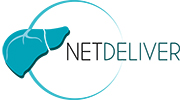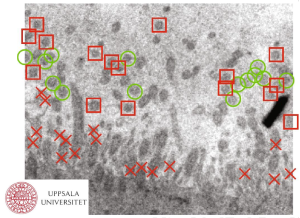| News | |
|
|
Articles about template matching
|
Two papers have been presented by Natasa Sladoje and Joakim Lindblad (Uppsala) about template matching. It consists in measuring distances between objects in images, suitable for information-rich object representations, capturing several properties in each image pixel.
References:
Distance Between Vector-Valued Fuzzy Sets Based on Intersection Decomposition with Applications in Object Detection. J. Öfverstedt, N. Sladoje, J. Lindblad. In International Symposium on Mathematical Morphology and Its Applications to Signal and Image Processing – ISMM, 2017.
Distance Between Vector-Valued Representations of Objects in Images with Application in Object Detection and Classification. N. Sladoje, J. Lindblad. In International Workshop on Combinatorial Image Analysis – IWCIA, 2017.
Master dissertation Anh-Khoa Vo Van
|
Anh-Khoa Vo Van (UCA) has defended his Master thesis about numerical simulation of blood flow within liver parenchyma. Congratulations!
Reference:
Biomechanical exploratory study of blood flows in the hepatic structure. A.K. Vo Van. SIGMA, 2017.
Abstract:
The objective of the project is to simulate the blood circulation in the liver. The
geometry of the liver is obtained from medical images. The liver is then modeled as a porous medium that verifies Darcy’s law. We use the Abaqus software to perform the simulation with the finite element method, the software calculates the pressure in the pores and blood flow velocity. We check the Darcy equation in the porous medium using two simple examples: infiltration through a dam and then a simplified hepatic lobule. These two models allow us to compare the numerical results and analytical results, and to validate Darcy’s law implemented in Abaqus. We have also created a hexagonal lobule, which aims to compare with the article by J. H. Siggers et al. We then investigated a complete liver model, using the geometry available on the IRCAD website. These are surface models that do not take volume into account. So, we used the CATIA software to reconstruct the geometry of the liver and its veins. Finally, Abaqus software allows us to simulate the flow of blood in the liver and its veins.
Article about 3D-2D registration of the liver
|
Adrien Bartoli (UCA) and his colleagues have proposed a novel registration of preoperative liver volume to intra-operative laparoscopy image. The application is to achieve augmented reality in laparoscopy for liver surgery. This work will be presented in MICCAI 2017 conference.
Reference: Deformable Registration of a Preoperative 3D Liver Volume to a Laparoscopy Image using Contour and Shading Cues
B. Koo, E. Özgür, B. Le Roy, E. Buc and A. Bartoli. MICCAI – International Conference on Medical Image Computing and Computer Assisted Intervention, 2017.



